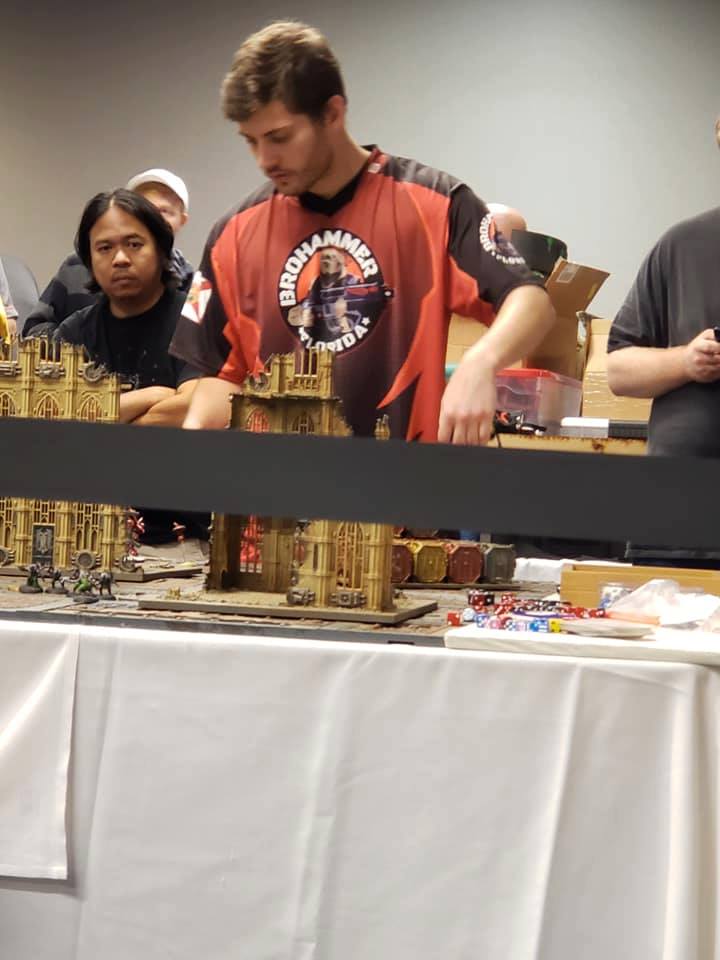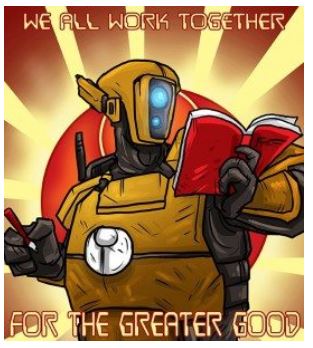
Rhys Jenkins brings us an analysis of Richard Siegler’s NOVA Open winning T’au list!
Richard Siegler recently won the Nova Open with T’au Empire. It’s not unusual to see T’au at the top tables at tournaments, and we certainly see T’au armies win events every now and then.
But this list was a little bit different.
It’s not quite a castle. There are no Broadsides. There is no Shadowsun. It’s not a point-n-click army.
So what’s going on? Let’s start at the beginning: here is Siegler’s list.
Siegler hits some classic T’au themes in the current meta: triple Riptide, triple Commander, lots of Shield Drones. This gives him solid, dependable output at 36” and super-charged, kill-on-sight output at 18”. And it’s all wrapped up in a super tanky Shield Drone bubble.
But he also takes the list to some unusual places: only five Fire Warriors, a mere six command points, and two-man (so to speak) squads of Shield Drones everywhere. This gives him a lot less anti-infantry dakka than most T’au lists and far less scope to lean on stratagems. And those MSU Shield Drones? Stick a pin in that for now.
Let’s check out Siegler’s alpha units. He runs three Riptides each armed with smart missile systems and a heavy burst cannon. In the support slots he chooses an advanced targeting system and a velocity tracker. Assuming he nova charges, each Riptide throws out 26 shots at 30”, eight at S5 AP1 D1 and 18 at S6 AP2 D2.
Putting aside markerlight support, these three models will average 12 S5 AP1 D1 hits and 27 S6 AP2 D2 hits a turn. While he’ll struggle to bring down a Knight with those numbers, he’ll rip through infantry and light vehicles with ease. There is a reason that Riptides are the best T’au battlesuit (let’s not talk about the really big one).
Next, he runs three Commanders each armed with three cyclic ion blasters and an advanced targeting system. When these boys get into range, they do some serious work. Each Commander kicks out nine S7 AP2 D1 shots at 18”, which ain’t too shabby. But with the CIB it’s all about the overcharge: S8 AP2 Dd3. And remember that T’au Commanders hit on 2s, so this firepower is highly accurate even without the application of markerlights. Adding just the one ‘light to reroll those 1s and Siegler can virtually guarantee a full house of hits.
So far, so classic T’au. Let’s dig deeper.
Siegler runs two five-man squads of Pathfinders. While ten 4+ markerlights can be useful, the infantry are a tax for the real utility of the squad: more Drones. Each Pathfinder squad comes with two more Shield Drones, as well as a Recon Drone, a Pulse Accelerator Drone, and a Grav-Inhibitor Drone.
The Recon Drone has a BS5 burst cannon and allows Pathfinders to ignore enemy cover when they shoot. While this is nothing particularly threatening offensively, it does have respectable defensive capabilities. It can use the saviour protocols rule and has two wounds, making it a useful tool to have around to pass off damage.
The Pulse Accelerator Drone increases the range of Pathfinders and Fire Warriors’ weapons by 6”. T’au lists heavy on infantry often include this Drone, and in Sielger’s list it does make his overwatch slightly more effective when combined with a Cadre Fireblade’s volley fire ability, but it’s nothing to write home about. It is, of course, another Drone to which he can pass off wounds with saviour protocols.
The Grav-Inhibitor Drone is a particularly useful addition. Forcing the subtraction of d3” from charges within 12”, this little guy will be a thorn in the side of assault-focused armies, and while it won’t stand up to any real firepower, it is another unit that the opponent has to consider when planning both his shooting phases and his charge phases. We’ll return to this theme later on.
In addition to markerlights and Drones, Siegler’s Pathfinders also offer surprisingly decent mobility. On the third Art of War podcast, Seigler discusses how he uses the Pathfinders’ pre-game move to advance up the board in order to move-block high value targets. This would give the Pathfinders themselves a 14” plus advance range to get into position, forcing his opponent to deal with them or concede valuable movement. And it’s not just the Pathfinders themselves that benefit from this ability; the Drones in the squad also gain a pre-game move. This utility adds to Siegler’s significant board control threat.
Siegler supplements his strong offensive output and unorthodox defensive trickery with dependable markerlight support in the form of three Cadre Fireblades and Darkstrider. These four models have two things that make them very strong additions to any T’au list: BS2 and the character keyword. T’au players know how useful markerlights hitting on 2s are, and for most of the game these models will be untargetable. Moreover, if the enemy bypasses the character keyword with snipers, there will be plenty of Drones on the board to tank the wounds with saviour protocols.
But Siegler’s list stands out when we look at the Drones. Siegler runs 43 Drones in total, and of those 43, 37 are Shield Drones. This gives his alpha units serious staying power. Opponents would need to get six wounds on average to break through saviour protocols saves, assuming Sielger doesn’t use a command reroll.
Moreover, saviour protocols turn any wound, and any potential damage, into one mortal wound on the Drone. In this way, lasguns are the same as lascannons when it comes to saviour protocols. And then each one of those wounds has a one in three chance of being discarded by the Shield Drone’s 5+++. High level T’au lists tend to lean heavily on Drones and saviour protocols, and Siegler takes this theme and really runs with it.
But it’s not just the number of Shield Drones that cause opponents such problems. It’s also that Siegler takes so many of these Drones in two-man squads. He attaches two Drones to his Commanders. He attaches two Drones to his Cadre Fireblades. He attaches two Drones to his Pathfinders. And so on. This MSU approach to his Drones gives Siegler significant scope to move out into the midfield and sit on objectives and block lanes of movement with units that are surprisingly tricky to remove. That T4, 4++, and 5+++ makes deciding what to shoot at them a little more difficult than many players think.
Indeed, Siegler’s T’au emphasises this non-dice aspect of the game. Deciding how many shots to put into those two Shield Drones, deciding how best to split fire to get those two Drones out of that movement lane, deciding whether or not to shoot at the Riptide or just shoot at the Drones beepbooping around: these decisions cost brainpower. And high level 40k is a tiring game. Players will play three or four games a day at the big tournaments, and most players know how exhausting one 2,000-point game can be. Consider this: it’s your third game of the day. It’s getting into the evening. You’ve been rolling dice all afternoon. You’re tired. You’re looking forward to a beer. Not only do you have to keep track of those Riptides and those Commanders, but you’ve also got to decide how many stalker bolt rifles you’re going to shoot at that Drone squad in the ruin. Will your five Wyches really kill those two Drones hovering over the objective? Can you rely on smite to destroy those two Drones that are somehow in your deployment zone? They do have a pesky 5+++.
The Nanavatis and the Vesals of the 40k world probably weigh up those decisions in a couple of moments flat, but the average player at a tournament would have more trouble. Hell, I’d have more trouble. And I play T’au.
So we know Siegler takes a lot of Drones, and we know that those Drones are going to be all over the place, but what does sacrifice to do this? There’s a concept in economics called opportunity cost. Simply put, opportunity cost is the opportunity you forgo by doing one thing over doing another thing. If you spend an hour at the shops, that’s an hour that you can’t spend getting a haircut or walking the dog. The cost of going to the shop isn’t only the time and money you spend, it’s also what you aren’t doing.
How does this apply to 40k? When Sielger spends 370 points on Shield Drones, that is points he’s not spending on anything else. So what does he forgo for that amount of defense and board control? Three Broadsides each armed with smart missile systems, high-yield missile pods, and a targeting array run to 363 points. That’s a lot of missiles to miss out on. A couple of Hammerheads each armed with smart missile systems and an ion cannon would run to 330 points. That’s some solid gunboat banter that he’s leaving in the carry case.
But then again this would be missing the point of the list. Siegler’s isn’t a T’au list that relies on a massive alpha strike. His isn’t a T’au list that centers around a virtually unchargeable castle. His isn’t a T’au list that throws out an ungodly amount of dakka. Siegler’s list nods to these play styles but doesn’t conform to them. Like that new album from your favourite band: you can hear the classic stuff in there but this is original. It knows where it came from but it’s going somewhere new.
Siegler arrives at a T’au list that can break face at 18”, but doesn’t need to be there until turn four. He arrives at a T’au list that takes recon and gets it most turns. He arrives at a T’au list that will aim for hold more instead of kill more. It’s triptide with a difference. It’s all outrider no battalion. But at its heart it’s a proper T’au list.
And remember, Frontline Gaming sells gaming products at a discount, every day in their webcart!

